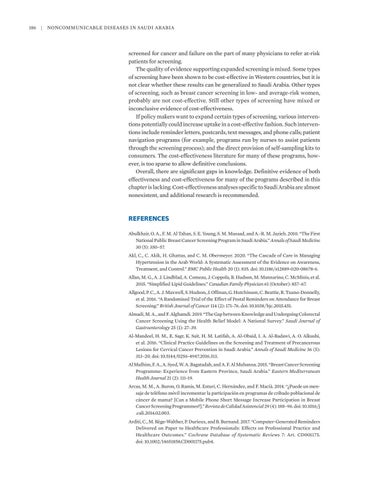186 | Noncommunicable Diseases in Saudi Arabia
screened for cancer and failure on the part of many physicians to refer at-risk patients for screening. The quality of evidence supporting expanded screening is mixed. Some types of screening have been shown to be cost-effective in Western countries, but it is not clear whether these results can be generalized to Saudi Arabia. Other types of screening, such as breast cancer screening in low- and average-risk women, probably are not cost-effective. Still other types of screening have mixed or inconclusive evidence of cost-effectiveness. If policy makers want to expand certain types of screening, various interventions potentially could increase uptake in a cost-effective fashion. Such interventions include reminder letters, postcards, text messages, and phone calls; patient navigation programs (for example, programs run by nurses to assist patients through the screening process); and the direct provision of self-sampling kits to consumers. The cost-effectiveness literature for many of these programs, however, is too sparse to allow definitive conclusions. Overall, there are significant gaps in knowledge. Definitive evidence of both effectiveness and cost-effectiveness for many of the programs described in this chapter is lacking. Cost-effectiveness analyses specific to Saudi Arabia are almost nonexistent, and additional research is recommended.
REFERENCES Abulkhair, O. A., F. M. Al Tahan, S. E. Young, S. M. Musaad, and A.-R. M. Jazieh. 2010. “The First National Public Breast Cancer Screening Program in Saudi Arabia.” Annals of Saudi Medicine 30 (5): 350–57. Akl, C., C. Akik, H. Ghattas, and C. M. Obermeyer. 2020. “The Cascade of Care in Managing Hypertension in the Arab World: A Systematic Assessment of the Evidence on Awareness, Treatment, and Control.” BMC Public Health 20 (1): 835. doi: 10.1186/s12889-020-08678-6. Allan, M. G., A. J. Lindblad, A. Comeau, J. Coppola, B. Hudson, M. Mannarino, C. McMinis, et al. 2015. “Simplified Lipid Guidelines.” Canadian Family Physician 61 (October): 857–67. Allgood, P. C., A. J. Maxwell, S. Hudson, J. Offman, G. Hutchinson, C. Beattie, R. Tuano-Donnelly, et al. 2016. “A Randomised Trial of the Effect of Postal Reminders on Attendance for Breast Screening.” British Journal of Cancer 114 (2): 171–76. doi: 10.1038/bjc.2015.451. Almadi, M. A., and F. Alghamdi. 2019. “The Gap between Knowledge and Undergoing Colorectal Cancer Screening Using the Health Belief Model: A National Survey.” Saudi Journal of Gastroenterology 25 (1): 27–39. Al-Mandeel, H. M., E. Sagr, K. Sait, H. M. Latifah, A. Al-Obaid, I. A. Al-Badawi, A. O. Alkushi, et al. 2016. “Clinical Practice Guidelines on the Screening and Treatment of Precancerous Lesions for Cervical Cancer Prevention in Saudi Arabia.” Annals of Saudi Medicine 36 (5): 313–20. doi: 10.5144/0256-4947.2016.313. Al Mulhim, F. A., A. Syed, W. A. Bagatadah, and A. F. Al Muhanna. 2015. “Breast Cancer Screening Programme: Experience from Eastern Province, Saudi Arabia.” Eastern Mediterranean Health Journal 21 (2): 111–19. Arcas, M. M., A. Buron, O. Ramis, M. Esturi, C. Hernández, and F. Macià. 2014. “¿Puede un mensaje de teléfono móvil incrementar la participación en programas de cribado poblacional de cáncer de mama? [Can a Mobile Phone Short Message Increase Participation in Breast Cancer Screening Programmes?].” Revista de Calidad Asistencial 29 (4): 188–96. doi: 10.1016/j .cali.2014.02.003. Arditi, C., M. Rège-Walther, P. Durieux, and B. Burnand. 2017. “Computer-Generated Reminders Delivered on Paper to Healthcare Professionals: Effects on Professional Practice and Healthcare Outcomes.” Cochrane Database of Systematic Reviews 7: Art. CD001175. doi: 10.1002/14651858.CD001175.pub4.

